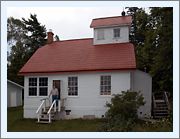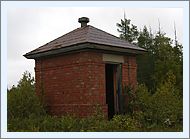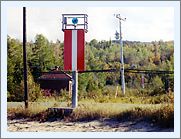|
Historical Information

The village of Eagle Harbor sits on the
western edge of a small bay some sixteen miles west of Copper Harbor,
and first gained significance when Edward Taylor constructed a pier in
the bay in 1844. A rocky shallow bar stretching across the mouth of the
bay made entry into the harbor extremely treacherous, as vessels were
forced to "thread the needle" through a narrow area in the
bar, which was the only area where the water deepened, and even then
only to a depth of under ten feet.
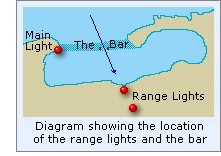 To assist vessels in locating the
narrow opening in the bar, local mariners quickly installed a day range
on the shore. While no record of the appearance or construction of this private
range has survived, it likely consisted of two white wooden poles or skeletal towers placed on shore in a direct line with
the opening in the bar. From a safe distance beyond the bar, mariners
would move parallel to the shore to a point at which the two ranges
lined-up one behind the other. Keeping the ranges thus aligned as they
turned shoreward and entered the harbor put them on a course safely
through the opening. Since these ranges
were unlighted, they only served their purpose during daylight hours,
and vessels wishing to enter the harbor at night were forced to wait
offshore until sunrise or chance breaking up on the rocks of the bar. To assist vessels in locating the
narrow opening in the bar, local mariners quickly installed a day range
on the shore. While no record of the appearance or construction of this private
range has survived, it likely consisted of two white wooden poles or skeletal towers placed on shore in a direct line with
the opening in the bar. From a safe distance beyond the bar, mariners
would move parallel to the shore to a point at which the two ranges
lined-up one behind the other. Keeping the ranges thus aligned as they
turned shoreward and entered the harbor put them on a course safely
through the opening. Since these ranges
were unlighted, they only served their purpose during daylight hours,
and vessels wishing to enter the harbor at night were forced to wait
offshore until sunrise or chance breaking up on the rocks of the bar.
In the annual inspection of the area in
1863, the Lighthouse Board Inspector noted that a similar day range had been installed by private interests in Copper Harbor, and that both
locations would benefit by the installation of lighted ranges to
facilitate safe entry at all times of day. While it was further
noted that of the two locations the need was most pressing at Eagle
Harbor, no action was taken by the Board towards seeking the necessary funding,
since the majority of Federal Government's funds being diverted to
support the Civil War.
The Civil War behind them, the Army Corps of Topographical Engineers
dispatched an officer to Eagle Harbor to supervise a project of harbor
improvement in 1866. With a plan to enlarge the opening in the bar to a
width of 130 feet and a depth of 14 feet, the resulting improvement opened
the harbor to the largest vessels of the day, allowing it to serve as
one of a chain of harbors of refuge planned for Superior's south shore.
With the exact location of the enlarged
channel known in 1873, the engineer in charge suggested
that the time was right for the construction of the range lights, and
the Lighthouse Board in turn recommended their construction in its
annual report for that year.
 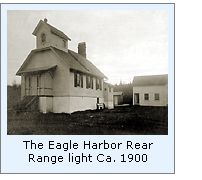 Congress responded favorably with an
appropriation of $8,000 on March 3, 1875, and the District Inspector
visited Eagle Harbor to negotiate for the purchase of the necessary land
for the station on a location close to the mouth of the Cedar River.
While the site selected was low and swampy, it was predicated by the
location of the new channel. As was frequently the case, title to the
land was not quickly obtained, and it was not until the spring of 1877
that a clear title was finally obtained. Construction of the ranges
began immediately, just as work on opening the new channel through the
bar was completed. Congress responded favorably with an
appropriation of $8,000 on March 3, 1875, and the District Inspector
visited Eagle Harbor to negotiate for the purchase of the necessary land
for the station on a location close to the mouth of the Cedar River.
While the site selected was low and swampy, it was predicated by the
location of the new channel. As was frequently the case, title to the
land was not quickly obtained, and it was not until the spring of 1877
that a clear title was finally obtained. Construction of the ranges
began immediately, just as work on opening the new channel through the
bar was completed.
The plan drawn up for the Eagle Harbor
range lights was a new design, but ended-up being duplicated at Copper
Harbor in 1869, and at Presque Isle and Baileys Harbor in 1870. The rear
range was a two-story wood frame keeper's dwelling with a small wooden
lantern on the peak at the end of the roof facing the lake. The first
floor contained a kitchen, living room and a bedroom, and the second
floor one large bedroom. A wooden staircase connected the two floors and
continued into the lantern, which was equipped with a tubular tin lamp
atop a small cast iron pedestal. The lantern was lined with copper
sheeting as a protection against fire, and shelves were built into the
walls to hold wicks and other supplies.
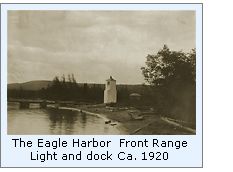 The front range consisted of a small
25-foot tall wooden structure, the lower section being square in plan,
with the upper half octagonal, capped with an iron roof with round
ventilator ball. A set of wooden stairs lead to a floor located at the
point at which the building became octagonal, with a tubular tin lamp
similar to that in the rear range mounted on a small cast iron pedestal
centered on this floor. A window on the lake side of the structure
limited the visibility of the light to a small arc out in the lake, to
ensure that it was not visible until it was close to being lined-up below the light in
the rear range. A second, smaller window was located on the opposite
side, and was installed to allow the keeper to verify that the front
range light was working from within the comfort of the rear range
dwelling. The front range consisted of a small
25-foot tall wooden structure, the lower section being square in plan,
with the upper half octagonal, capped with an iron roof with round
ventilator ball. A set of wooden stairs lead to a floor located at the
point at which the building became octagonal, with a tubular tin lamp
similar to that in the rear range mounted on a small cast iron pedestal
centered on this floor. A window on the lake side of the structure
limited the visibility of the light to a small arc out in the lake, to
ensure that it was not visible until it was close to being lined-up below the light in
the rear range. A second, smaller window was located on the opposite
side, and was installed to allow the keeper to verify that the front
range light was working from within the comfort of the rear range
dwelling.
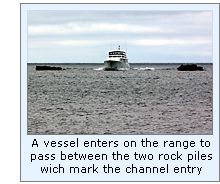 George Howard was appointed as the
station's first keeper, and reported for duty at the station on August
11, 1877. With work on the station complete, Howard officially exhibited
the Eagle Harbor Range Lights for the first time on the evening of
September 20, 1877. George Howard was appointed as the
station's first keeper, and reported for duty at the station on August
11, 1877. With work on the station complete, Howard officially exhibited
the Eagle Harbor Range Lights for the first time on the evening of
September 20, 1877.
In order to better mark the location of
the channel through the bar, two huge pine lumber cribs were constructed
on the ice at each side of the opening during the winter of 1878. Filled
with rock blasted from an area onshore, the ice was subsequently cut
away around the cribs, and they were lowered to the bottom.
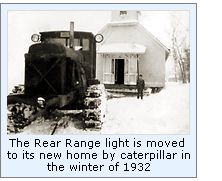 By virtue of the station's location,
the area was evidently frequently soggy, if not covered with water. To
help combat the rot that accompanies such dampness, the rear range
building was elevated two feet above its foundation in 1884, and new
foundation walls and a cellar were constructed beneath. 1894 saw the
replacement of the old tin lanterns with newer lens lanterns, and the
following year 1,000 feet of plank walk, elevated two feet off the
ground, was installed to allow movement between the two structures
without having to wade through the seemingly ever present standing water
and mud. By virtue of the station's location,
the area was evidently frequently soggy, if not covered with water. To
help combat the rot that accompanies such dampness, the rear range
building was elevated two feet above its foundation in 1884, and new
foundation walls and a cellar were constructed beneath. 1894 saw the
replacement of the old tin lanterns with newer lens lanterns, and the
following year 1,000 feet of plank walk, elevated two feet off the
ground, was installed to allow movement between the two structures
without having to wade through the seemingly ever present standing water
and mud.
Evidently the foundation modifications
undertaken in 1884 were insufficient, as the rear range building was
elevated a further two feet in 1901. The cellar floor was raised two
feet and a new concrete cellar floor was poured. A two-story barn was
built to the rear of the dwelling, and considerable re-grading was
undertaken to allow the water to drain in the area of the walkway
between the front and rear ranges.
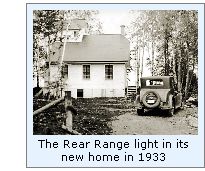 Unfortunately, by the end of the first
decade of the twentieth century, vessel traffic in and out of Eagle
Harbor had dwindled significantly, with the lighthouse tenders being
virtually the only large vessels entering the harbor. As a result, it
was determined that the range lights no longer served their former vital
function, and they were exhibited for the last time at the close of the
1911 season of navigation. Their only eulogy being an ignominious
entry in a listing of "stations which were discontinued during the
fiscal year" in the 1912 annual report of the Commissioner of
Lighthouses. Unfortunately, by the end of the first
decade of the twentieth century, vessel traffic in and out of Eagle
Harbor had dwindled significantly, with the lighthouse tenders being
virtually the only large vessels entering the harbor. As a result, it
was determined that the range lights no longer served their former vital
function, and they were exhibited for the last time at the close of the
1911 season of navigation. Their only eulogy being an ignominious
entry in a listing of "stations which were discontinued during the
fiscal year" in the 1912 annual report of the Commissioner of
Lighthouses.
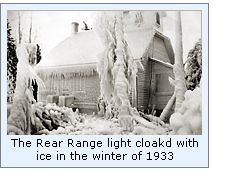 No longer serving any official purpose,
the rear range dwelling was offered for
sale at auction in 1930, with the stipulation that it would have to be
moved from its existing site. Detroit resident Gertrude Rowe entered a
bid of $400 for the structure, with the intention of moving it to her
property across Highway 26 to serve as a summer cottage. Being the
highest bidder, she arranged to pay the County Road Commission to use
one of their large tractors to make the move. Waiting until the winter
of 1932, when the ground would be frozen and the going easier, the tractor hitched up
to the wheeled platform which had been placed beneath the structure, and
the move was underway. Unfortunately, the wet conditions around the
building reared their ugly head once again, as the tractor became mired
in the mud beneath the snow. A second County tractor was dispatched to
the site, and freed the first, whereupon the dwelling slowly made its
way across the road to its new home. No longer serving any official purpose,
the rear range dwelling was offered for
sale at auction in 1930, with the stipulation that it would have to be
moved from its existing site. Detroit resident Gertrude Rowe entered a
bid of $400 for the structure, with the intention of moving it to her
property across Highway 26 to serve as a summer cottage. Being the
highest bidder, she arranged to pay the County Road Commission to use
one of their large tractors to make the move. Waiting until the winter
of 1932, when the ground would be frozen and the going easier, the tractor hitched up
to the wheeled platform which had been placed beneath the structure, and
the move was underway. Unfortunately, the wet conditions around the
building reared their ugly head once again, as the tractor became mired
in the mud beneath the snow. A second County tractor was dispatched to
the site, and freed the first, whereupon the dwelling slowly made its
way across the road to its new home.
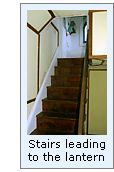 While it is not known what became of
the front range light, the rear range still serves as a summer cottage for Gertrudes' son
Dr. Robert Rowe and his family, and is locally known as the
"Tower and Lantern" cottage. While it is not known what became of
the front range light, the rear range still serves as a summer cottage for Gertrudes' son
Dr. Robert Rowe and his family, and is locally known as the
"Tower and Lantern" cottage.
In the latter part of the twentieth
century, the range lights were replaced with a pair of simple steel
poles with red and white daymarks and modern acrylic optics, which still
serve to guide pleasure boaters making their way into Eagle Harbor. Although most visitors likely have no idea
as to its original purpose, the old brick oil storage
building still stands sentinel duty close to the new front range light. The
lone reminder of a different time, and of faithful keepers long since
departed.

Keepers of
this Light

Click here
to see a complete listing of all Eagle Harbor Range Light keepers
compiled by Phyllis L. Tag of Great Lakes Lighthouse Research.

Seeing this Light

Located
round the bay to the east of the village of Eagle Harbor at the entrance
to Cedar Creek. Keep an eye out for the old oil storage building.

Contact information

Eagle Harbor Light Station Museum Complex
Star Route 1
Eagle Harbor, MI 49951
(906) 337-1263

Reference Sources

Annual reports of the Lighthouse Board, 1863 - 1901
Annual reports of the Commissioner of Lighthouses, 1909 -1912
Great Lakes Light Lists, various, 1877 through 1995
History of Eagle Harbor, Michigan, Clarence J. Monette, 1977
History of the Great Lakes, J. H. Beers Co, 1899
Original prints of lighthouses in the Michigan State Archives.
Historical photographs courtesy of the Robert F. King & Doctor Rowe Collections.
Email from George Hite, 10/15/00
Thanks to the Rowe family for allowing us to photograph their historic
cottage in September 2004.
Keeper listings for this light appear courtesy of Great
Lakes Lighthouse Research
|
